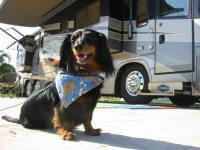Traveling with your cat can be challenging but there are steps you can take to make the experience if not pleasant then at least less stessful.
The Perfect Carrier
Despite previous unpleasant experiences, a cat can be taught that a carrier and travel don't have to be stressful. A carrier is important for everyone's safety and should be a cozy secure space. The right carrier should be sturdy and open quietly from both the top and the side. The top should come off quickly and easily to allow access to your kitty without pulling or tipping him out.
A Happy Place
Make the carrier a place that your cat likes to be in at home. Put it somewhere convenient for both you and your cat. Keep the door open or the top off, for easy access and put a soft towel inside. You can use dangly toys to encourage your cat to climb into and out of the carrier. Feeding your kitty inside the open carrier helps change associations in a good way. Facial pheromones (feliway.com) can be sprayed in or wiped inside the carrier to increase the sense of security. Try to apply it 15-30 minutes before your cat gets into the carrier so the alcohol in the spray evaporates.
Practice Makes Perfect
When your cat climbs into the carrier, immediately praise him and give him a reward. Over a few days to weeks, once your cat associates the carrier with rewards, close the door to the carrier before you praise and reward. Open the door again so he can come out at will.
Ready For Lift-Off
When (re)training your cat or kitten to be a fear-free traveler, it is important to break the trip down in to the following little steps, providing rewards at each step to be sure that your cat is comfortable with each one before moving on to the next step on the next day. Wean him, or her, into the new stress-free experience, one new step at a time:
- Cover the carrier with a towel or blanket
- Hold the carrier steady with a hand on either side, or stabilize it with one hand under it and the other on the handle
- Place the carrier on the back seat of the car (away from potential airbag harm) and secure it with a seatbelt
- Close the door, get into the front seat and close the door and start the engine
- Drive to the end of the driveway and back.
Begin with short trips around the block, then incease to slightly longer drives, working up to a drive to the practice (without the cat being examined or handled) to complete the process.




















